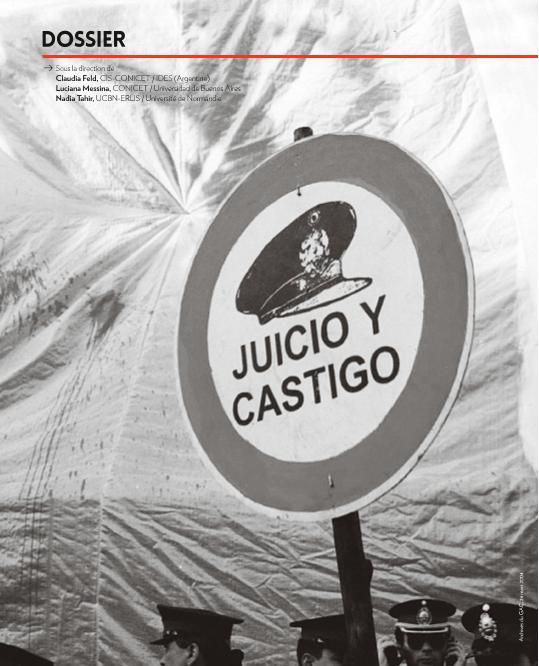Mostrar el registro sencillo del ítem
dc.contributor.author
Feld, Claudia Viviana

dc.date.available
2016-02-05T19:18:35Z
dc.date.issued
2014-09
dc.identifier.citation
Feld, Claudia Viviana; "Subversifs", "torturés", "NN": comment la presse argentine de la transition a-t-elle nommé les victimes du terrorisme d'État?; Auschwitz Foundation; Testimony Between History and Memory; 118; 9-2014; 114-120
dc.identifier.issn
0772-652X
dc.identifier.uri
http://hdl.handle.net/11336/4080
dc.description.abstract
En 1984, au cours des premiers mois de la transition démocratique en Argentine, les médias ont commencé à aborder, comme sujet principal, la question des disparus et la répression clandestine. Dans le cadre du « destape » (révélation) médiatique, qui commença dans la presse non censurée, cette présentation journalistique, loin d’informer clairement sur le terrorisme d’État, a généré un spectacle macabre et sensationnaliste que certains observateurs de l’époque ont appelé le « show de l’horreur ». Cet article analyse comment a été construite la figure de la victime de la disparition forcée dans la presse argentine publiée entre janvier et mai 1984. L’utilisation de la notion de « victimes » de violations des droits de l’homme ou de « victimes innocentes » de la répression politique pour faire référence aux disparus n’a pas surgi immédiatement dans l’espace de la presse. D’autres figures, telles que celle de « subversifs », « torturés » ou « NN » étaient utilisées. Dans la mesure où cette couverture médiatique a été la première présentation des faits concernant les disparus à un public massif, notre analyse permet de proposer certaines hypothèses relatives aux « luttes entre mémoires » au début de la transition.
dc.description.abstract
In 1984, during the first months of the democratic transition in Argentina, the media started to deal with, mainly, the disappeared and the clandestine repression. Within the context of the media “destape” (uncovering) which first occurred in the uncensored press, such media treatment, far from uncovering clear information about the state’s terrorism, produced a gruesome and sensationalist picture that some observers dubbed the “horror show”. This paper examines the way in which the figure of the “victims” of forced disappearance was elaborated in the Argentinian press between the months of January and May 1984. In relation to the disappeared, the notion of “victims” of human rights violations or “innocent victims” that of political repression were not used in the media in the first place. Instead, other figures, such as “subversives”, “tortured” or “NN”, were made use of. As the press coverage examined in this paper was the first presentation of the facts related to the disappeared to a massive audience, our study presents some hypotheses in relation to “memory conflicts” at the beginning of the transition.
dc.description.abstract
In 1984, tijdens de eerste maanden van de democratische transitie in Argentinië, zijn de media begonnen met het aankaarten, als het belangrijkste onderwerp, van het probleem van de vermisten en illegale repressie. In het kader van de mediatieke ‘destape’ (openbaring), die in de ongecensureerde pers begon, genereerde de journalistieke presentatie, met een verre van duidelijke informatie over staatsterrorisme, een macabere sensatie waaruit blijkt dat sommige hedendaagse waarnemers ‘Horror Show’ noemden. Dit artikel analyseert hoe de figuur van het slachtoffer van gedwongen verdwijning werd opgebouwd in de Argentijnse gepubliceerde pers tussen januari en mei 1984. Het gebruik van de term ‘slachtoffers’ van de schendingen van de mensenrechten of ‘onschuldige slachtoffers’ van politieke onderdrukking om te verwijzen naar de vermisten is niet onmiddellijk in de schrijfruimte van de pers terecht gekomen. Andere personages, zoals die van ‘subversieve’, ‘gekwelde’ of ‘NN’ werden vaak gebruikt. Voor zover deze mediatieke dekking de eerste voorstelling van de feiten over de vermisten was aan het grote publiek, stelt onze analyse ons in staat om een aantal hypotheses over ‘strijd tussen herinneringen’ in te vullen die plaats vonden aan het begin van de overgangsperiode.
dc.format
application/pdf
dc.language.iso
fra
dc.publisher
Auschwitz Foundation
dc.rights
info:eu-repo/semantics/openAccess
dc.rights.uri
https://creativecommons.org/licenses/by-nc-sa/2.5/ar/
dc.subject
Prensa
dc.subject
Memoria
dc.subject
Transición
dc.subject
Desaparecidos
dc.subject.classification
Comunicación de Medios y Socio-cultural

dc.subject.classification
Comunicación y Medios

dc.subject.classification
CIENCIAS SOCIALES

dc.title
"Subversifs", "torturés", "NN": comment la presse argentine de la transition a-t-elle nommé les victimes du terrorisme d'État?
dc.title
“Subversive”, “tortured”, “NN”: how did the Argentinian press referred to the victims of state terrorism during the democratic transition?
dc.title
"Subversieve elementen", "gefolterden", "NN": De slachtoffers van de staatsterreur in de Argentijnse overgangspers
dc.type
info:eu-repo/semantics/article
dc.type
info:ar-repo/semantics/artículo
dc.type
info:eu-repo/semantics/publishedVersion
dc.date.updated
2016-03-30 10:35:44.97925-03
dc.journal.volume
118
dc.journal.pagination
114-120
dc.journal.pais
Bélgica

dc.journal.ciudad
Bruselas
dc.description.fil
Fil: Feld, Claudia Viviana. Instituto de Desarrollo Económico y Social; Argentina. Consejo Nacional de Investigaciones Cientificas y Tecnicas. Oficina de Coordinacion Administrativa Parque Centenario. Centro de Investigaciones Sociales; Argentina
dc.journal.title
Testimony Between History and Memory
dc.relation.alternativeid
info:eu-repo/semantics/altIdentifier/url/https://temoigner.revues.org/957#quotation
dc.relation.alternativeid
info:eu-repo/semantics/altIdentifier/doi/http://dx.doi.org/DOI:10.4000/temoigner.957
dc.relation.alternativeid
info:eu-repo/semantics/altIdentifier/issn/0772-652X
Archivos asociados
